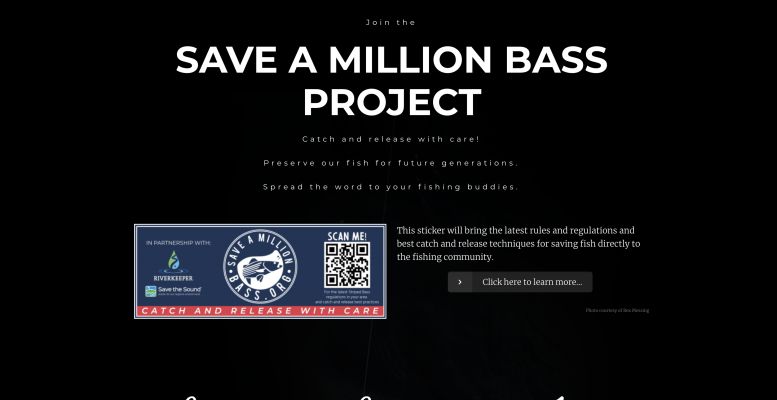Father-son team Steve and Joe Liesman create initiative to save Atlantic striped bass
In order to prevent further depletion of the already-thinning Atlantic striped bass population, a new program Save a Million Bass (SAMB) debuted on May 8 as the brainchild of Pelham father-and-son team Steve and Joe Liesman. The initiative involves educating recreational fishers about recently-adopted fishing regulations and better catch-and-release practices to increase fish survival. To spread awareness, SAMB is posting QR-code stickers at fishing locations throughout New York.
The Liesmans came up with the environmental project during the pandemic. SAMB is working in partnership with the Riverkeeper and Save the Sound.
“It’s simple, high-tech, and potentially very effective,” said Steve Liesman. “We believe this will be a major advancement in conservation because it brings vital information right to anglers in places where it’s difficult to get to them—on the dock and even on the water. To be a conservationist is to be an optimist. You have to believe you can make a difference, that your efforts will have an impact and that others will join you to achieve your goals, as impossible as they may sometimes seem. The Save a Million Bass project is born of that optimism. It has been formed because striped bass stocks are once again in crisis and that better catch-and-release practices can play a vital role in helping restore the abundance of stripers.”
Steve Liesman, a fisherman and a conservationist for several decades, is on the board of Riverkeeper and has been practicing catch and release as a striped bass fly fisherman for almost 30 years. Joe Liesman, who grew up fishing for striped bass in the Cape Cod Bay and Long Island Sound, graduated from Carleton College with a B.A. in environmental studies. He spent two summers interning at Riverkeeper, and after graduating, worked as a field technician for Trout Unlimited on the Delaware River and in the Catskill Mountains.
According to the Atlantic States Marine Fishery Commission, striped bass stocks are overfished. Until recently, the subspecies was making a comeback from a sharp decline in population in the mid 1980s. However, the species is again in a period of decline. Studies by fisheries biologists show that there aren’t enough fish with the capability of reproducing to replenish stocks faster than they are being depleted.
“In order to prevent the same type of catastrophic decline we saw decades ago, we must take action immediately,” said the SAMB website.
In 2017, an estimated 3.4 million stripers died after catch and release, or 9% of total recreational releases, the website said. “With so many anglers targeting stripers, this accounts for about half of the total fish mortality for the year.”
Dick Russell, an environmental journalist, wrote “Striper Wars: An American Fish Story.” In order to revive the population of the Atlantic striped bass in the eighties, said Russell, it eventually took the complete shutting down of all the fishing along the Atlantic Coast. “Striped bass migrates from North Carolina all the way to Maine and sometimes even to Nova Scotia,” he said. “And, eventually, the state of Maryland, which is where most of the stripers on the Atlantic Coast come from, declared a five-year moratorium. And when they shut down the fishery in the spawning grounds, I knew that that was gonna do it.”
Suggestions listed on the SAMB website for safer catch-and-release practices include:
- Keep the fish in the water.
- Use circle hooks. Non-offset circle hooks prevent deep-hooking fish, which is the number one cause of catch and release mortality.
- If the hook penetrates the fish’s gut, don’t pull it out. Instead, snip the line as close to the hook’s eye as possible.
- Minimize fight time. A long battle can exhaust the creature beyond recovery.
- Moderate photo-taking. Holding the fish vertically out of the water can damage its mouth and inner-organs.
- Take steps to revive fish that aren’t breathing. Hold the fish headfirst into the current so that water can flow through its gills. Once it regains its breath (it should try to slip out of your grasp), let it go.
- Fish only what you need. One fish can feed up to four people. If you want to keep the fish, be conscious of how much you really need to catch to feed yourself satisfactorily.
Evan Kaplan is a seventh grader at Pelham Middle school. He has many academic interests and aspirations, including being a staff reporter for the Pelham...












